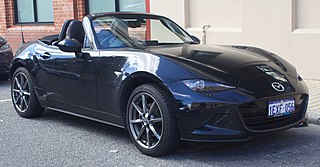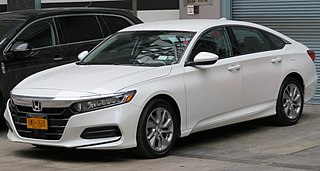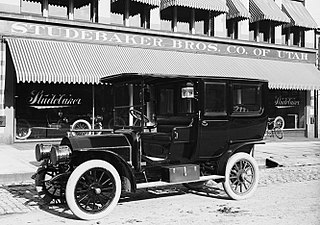Related Research Articles

Automobiles Ettore Bugatti was a German then French manufacturer of high-performance automobiles. The company was founded in 1909 in the then-German city of Molsheim, Alsace, by the Italian-born industrial designer Ettore Bugatti. The cars were known for their design beauty and for their many race victories. Famous Bugatti automobiles include the Type 35 Grand Prix cars, the Type 41 "Royale", the Type 57 "Atlantic" and the Type 55 sports car.

The automotive industry comprises a wide range of companies and organizations involved in the design, development, manufacturing, marketing, and selling of motor vehicles. It is one of the world's largest industries by revenue. It is also the industry with the highest spending on research & development.
A classic car is an older car, typically 25 years or older, though definitions vary. The common theme is of an older car of historical interest to be collectible and tend to be restored rather than scrapped. Classic cars are a subset of a broader category of "collector cars". A subset of what is considered classic cars are known as antique cars or vintage cars (manufactured pre-World War II.
Grand Prix motor racing, a form of motorsport competition, has its roots in organised automobile racing that began in France as early as 1894. It quickly evolved from simple road races from one town to the next, to endurance tests for car and driver. Innovation and the drive of competition soon saw speeds exceeding 100 miles per hour (160 km/h), but because early races took place on open roads, accidents occurred frequently, resulting in deaths both of drivers and of spectators. A common abbreviation used for Grand Prix racing is "GP" or "GP racing".

An antique car is an automobile that is an antique. Narrower definitions vary based on how old a car must be to qualify. The Antique Automobile Club of America defines an antique car as over 25 years of age. However, the legal definitions for the purpose of antique vehicle registration vary widely. The antique car era includes the Veteran era, the Brass era, and the Vintage era, which range from the beginning of the automobile up to the 1930s. Later cars are often described as classic cars. In original or originally restored condition antiques are very valuable and are usually either protected and stored or exhibited in car shows but are very rarely driven.

A roadster is an open two-seat car with emphasis on sporting appearance or character. Initially an American term for a two-seat car with no weather protection, usage has spread internationally and has evolved to include two-seat convertibles.

The Brass Era is an American term for the early period of automotive manufacturing, named for the prominent brass fittings used during this time for such things as lights and radiators. It is generally considered to encompass 1896 through 1915, a time when these vehicles were often referred to as horseless carriages.

Mid-size—also known as intermediate—is a vehicle size class which originated in the United States and is used for cars larger than compact cars and smaller than full-size cars. "Large family car" is a UK term and a part of the D-segment in the European car classification. Mid-size cars are manufactured in a variety of body styles, including sedans, coupes, station wagons, hatchbacks, and convertibles. Compact executive cars can also fall under the mid-size category.

Automotive design is the process of developing the appearance of motor vehicles - including automobiles, motorcycles, trucks, buses, coaches, and vans.

Development of the automobile started in 1672 with the invention of the first steam-powered vehicle, which led to the creation of the first steam-powered automobile capable of human transportation, built by Nicolas-Joseph Cugnot in 1769. Inventors began to branch out at the start of the 19th century, creating the de Rivas engine, one of the first internal combustion engines, and an early electric motor. Samuel Brown later tested the first industrially applied internal combustion engine in 1826.

Lists of automobile-related articles cover a wide range of topics related to cars. The lists are organized by manufacturer, region, sport, technology and so on.

The ARCA Menards Series is an American stock car series, the premier division of the Automobile Racing Club of America (ARCA). It is considered a minor, semi-professional league of stock car racing, used as a feeder series into the three national touring series of NASCAR, and hosts events at a variety of track types including superspeedways, road courses, and dirt tracks. The series has had a longstanding relationship with NASCAR, including using former NASCAR Cup Series cars, hosting events in the same race weekend such as Daytona Speedweeks, and naming an award after NASCAR founder Bill France, Sr. However, the series was not officially affiliated with NASCAR until its buyout on April 27, 2018.

The automotive industry in China has been the largest in the world measured by automobile unit production since 2008. Since 2009, annual production of automobiles in China exceeds both that of the European Union and that of the United States and Japan combined.

A car is a wheeled motor vehicle used for transportation. Most definitions of cars say that they run primarily on roads, seat one to eight people, have four wheels, and mainly transport people rather than goods.

Fiat Automobiles S.p.A. is an Italian automobile manufacturer, formerly part of Fiat Chrysler Automobiles, and since 2021 a subsidiary of Stellantis through Italian factory FCA Italy. Fiat Automobiles was formed in January 2007 when Fiat S.p.A. reorganized its automobile business, and traces its history back to 1899 when the first Fiat automobile, the Fiat 4 HP, was produced.

A limousine, or limo for short, is a large, chauffeur-driven luxury vehicle with a partition between the driver compartment and the passenger compartment.

The automotive industry in the United States began in the 1890s and, as a result of the size of the domestic market and the use of mass production, rapidly evolved into the largest in the world. The United States was the first country in the world to have a mass market for vehicle production and sales and is a pioneer of the automotive industry and mass market production process. During the course of the 20th century global competitors emerged especially in the second half of the century primarily across European and Asian markets, such as Germany, France, Italy, Japan and South Korea. The U.S. is currently second among the largest manufacturer(s) in the world by volume.

The automotive industry in Japan is one of the most prominent and largest industries in the world. Japan has been in the top three of the countries with most cars manufactured since the 1960s, surpassing Germany. The automotive industry in Japan rapidly increased from the 1970s to the 1990s and in the 1980s and 1990s, overtook the U.S. as the production leader with up to 13 million cars per year manufactured and significant exports. After massive ramp-up by China in the 2000s and fluctuating U.S. output, Japan is currently the third largest automotive producer in the world with an annual production of 9.9 million automobiles in 2012. Japanese investments helped grow the auto industry in many countries throughout the last few decades.

The FIA World Endurance Championship is an auto racing world championship organized by the Automobile Club de l'Ouest (ACO) and sanctioned by the Fédération Internationale de l'Automobile (FIA). The series supersedes the ACO's former Intercontinental Le Mans Cup which began in 2010 and is the first endurance series of world championship status since the demise of the World Sportscar Championship at the end of 1992. The World Endurance Championship name was previously used by the FIA from 1981 to 1985.
References
- ↑ David Burgess Wise, The New Illustrated Encyclopedia of Automobiles